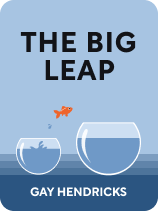

This article is an excerpt from the Shortform book guide to "The Big Leap" by Gay Hendricks. Shortform has the world's best summaries and analyses of books you should be reading.
Like this article? Sign up for a free trial here .
Are you feeling unfulfilled in life? Do you feel as though something is missing but can’t quite put your finger on what it is?
According to Gay Hendricks, the author of The Big Leap, a sense of dissatisfaction and lack of fulfillment often stems from what he calls the “Upper Limit Problem.” In other words, you’re feeling unfulfilled because you’ve reached a level of success and happiness that you’re not comfortable with.
Here’s how success propels you to your happiness threshold, according to Hendricks.
Success Propels You Toward Your Happiness Threshold
Many people who appear outwardly to be highly successful are feeling unfulfilled in life on a deep, fundamental level. Others may be thriving in one area of their life, such as their career, yet experience continual frustration and disappointment in another, perhaps in their relationships. If this sounds like you, you may be unconsciously limiting yourself by what Hendricks calls the “Upper Limit Problem,” an internal threshold for the maximum degree of success and happiness you’ll allow yourself to experience. This threshold works to prevent you from reaching what he calls your “Zone of Genius,” which we’ll refer to as living in a state of fulfillment.
| Life Dissatisfaction May Be Caused by Hedonic Adaptation Hendricks’s happiness threshold is similar to the positive psychology concept of hedonic adaptation, also referred to as a “hedonic treadmill,” described in The Paradox of Choice. This is the theory that we all have a natural “set point” for happiness, and we may have ebbs and flows, but when we have momentary happiness, we’ll always return back to that set point. Either the pleasure is fleeting because of the temporary nature of the experience (for example, a concert or a vacation), or we adjust to the new thing (as in a relationship). This model doesn’t necessarily suggest that we self-sabotage in order to bring ourselves down to this set point, but that it just naturally happens. You’ll stop enjoying things as much because you get used to them, like you would if you ate your favorite meal every day. Psychologists offer suggestions for combating the effect with strategies such as: rotating pleasurable activities, being mindful of savoring your pleasurable experiences, continuing to explore new activities, and journaling. |
Hedonic and Eudaimonic Happiness: Which Do We Have a “Threshold” For?
Philosophers have two concepts for happiness—hedonic and eudaimonic—which originate in Aristotle’s Nicomachean Ethics. Though he doesn’t explicitly name them, Hendricks seems to be alluding to these two types of happiness throughout the book, particularly when he describes why successful people often still feel unfulfilled.
Hedonic happiness is the kind of actively pleasurable feeling we get when we’re experiencing something that brings us joy or satisfaction in the moment. This is the feeling you might have when you’re at a party, or listening to your favorite song, or you buy a new car. By contrast, eudaimonic happiness is a more calm, sustained contentment. This is the kind of feeling derived from having a sense of greater purpose or meaning in your life. In other words, to experience eudaimonic happiness is to feel a sense of fulfillment.
Research has shown cultural differences in how people tend to define happiness. One study compared European Americans to Chinese Americans and found that the European-American notion of happiness was a more hedonic variety, while Chinese-Americans described a more eudaimonic notion of happiness. When Hendricks describes “successful” people having the tendency to have lingering dissatisfaction with their lives, this could be the result of the modern Western tendency to pursue hedonic happiness, at the expense of the more sustainable eudaimonic happiness. Could the happiness threshold he describes be a combination of the natural tendency for hedonic adaptation to occur, along with the fleeting nature of hedonic happiness? In other words, when we relentlessly chase this “high” kind of happiness and then achieve it, we are bound to experience disappointment when it doesn’t last.
Psychologists say that eudaimonic happiness is more related to life satisfaction and activities that are meaningful, and that this state is cultivated through mindfulness practices, positive self-acceptance, and discovering one’s purpose. So when Hendricks advises us to explore what activities give us the greatest satisfaction, to shift to a positive mindset, to reallocate our time to more meaningful pursuits, and to sustain that through regular meditation and positive affirmation, he may be advocating moving from the pursuit of hedonic happiness to discovering eudaimonic happiness.

———End of Preview———
Like what you just read? Read the rest of the world's best book summary and analysis of Gay Hendricks's "The Big Leap" at Shortform .
Here's what you'll find in our full The Big Leap summary :
- How to overcome the psychological barriers to success and fulfillment
- Why most people have a self-imposed limit to happiness
- How to identify your own false beliefs and stop self-sabotaging






